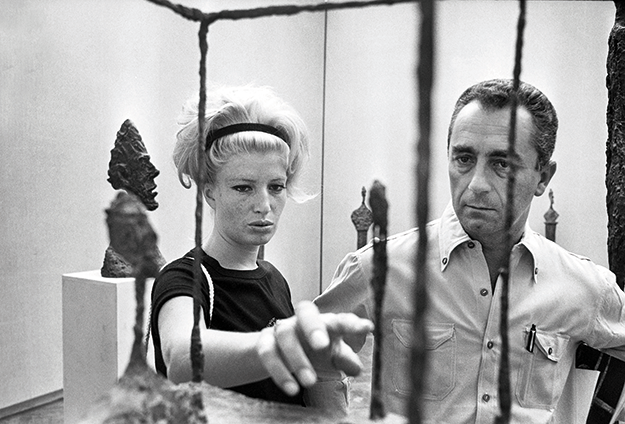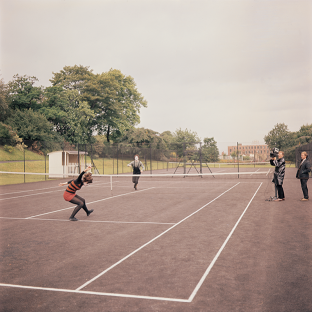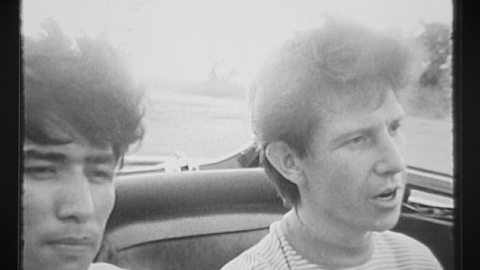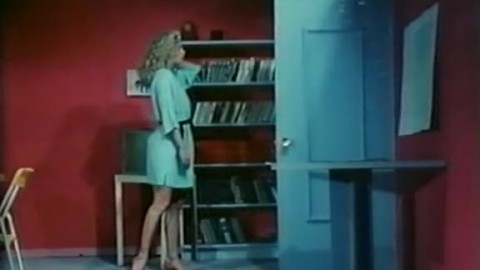Art/Form: Antonioni at the Cinémathèque Française

Monica Vitti et Michelangelo Antonioni à la Biennale de Venise de 1962, DR.
How do you hang a filmmaker? This question confronts any curator who mounts a gallery show about cinema. When works originally conceived for the black box of projection are transposed to the white cube of exhibition, something is bound to get lost in translation: the specifically cinematic experience of concentrated viewing and narrative duration, for starters. The work of Michelangelo Antonioni is a fascinating test-case of such a challenge, one to which the Cinémathèque Française’s major exhibition, curated by Dominique Païni, rises very satisfyingly.
It might be said that Antonioni’s films are intrinsically gallery-friendly. In a 1995 essay about the director’s first film, the documentary Gente del Po (People of the Po Valley, 1943), John Berger observed: “Those who admire Antonioni’s films often say that he narrates like a novelist. Those who criticize his films often accuse them of being abstract, over-aesthetic, formalist. It seems to me that if one wants to enter the world of his imagination, one should first think of him as a painter.”
But what sort of painter? The breathtaking monochrome imagist of L’Eclisse (62)? The colorist who couldn’t keep from bothering nature with his paintbrush and retouched Ravenna’s industrial blight to look just so in Red Desert (64)? Or the globetrotting pop-art auteur of Blow–Up (66) and Zabriskie Point (70)? In the Cinémathèque show, all of the above, and more besides.
The idea of Antonioni-as-painter—and as a visual artist more generally—is one of the principal thematic threads, signaled by the full title “Antonioni, at the origins of Pop – Cinema/Photography/Fashion.” Otherwise it’s a misleading tag, a sales pitch that trades on the director’s best-known film Blow–Up; the publicity image is the over-familiar shot of David Hemmings photo-tumescently straddling the prostrate model Veruschka. Once inside, though, we are presented with a richly comprehensive survey of Antonioni’s career, with archival treasures included for good measure.
Organized chronologically and arranged in nine distinct sections, the exhibition takes us from Antonioni’s early years in his birthplace of Ferrara, to his films with Lucia Bosè in the Fifties and Monica Vitti in the Sixties, the “international period” of the late Sixties and Seventies, and up through his return to Italy in the Eighties and the later phases of his work. Given the amount of material—projections, paintings, posters, photography, and all manner of archival bounty—it’s all well distributed throughout one long room divided lengthwise by rows of groaning vitrines, and with the sound bleed from the looping film excerpts kept to a minimum. By the time you come to the end, a real sense of Antonioni’s cumulative achievements has been conveyed.
The exhibition is a version of shows previously presented in 2013 at the Bozar Centre for Fine Arts in Brussels and the Gallery of Modern and Contemporary Art in Ferrara, home to the Antonioni archive, which is soon to be installed in its own museum. Païni’s additions to these previous presentations, which he also co-curated, include a gesture toward contemporary art, but these works, bunched together near the exit, feel like something of an afterthought, particularly when compared to the way the show integrates paintings alongside stills and sequences from Antonioni’s films.

Michelangelo Antonioni sur le tournage de Zabriskie Point, 1970. Photo Bruce Davidson © Bruce Davidson / Magnum Photos
While there’s nothing especially original about comparing Antonioni’s work to painting, what emerges is how deep the filmmaker’s dialogue with it ran. According to Barbara Guidi’s catalog essay, he was a serious collector, counting works by Francis Bacon, Roy Lichtenstein, Mark Rothko, and Giorgio Morandi among the many he acquired. He also corresponded with Morandi and Rothko. A letter dated 1953 is included among the show’s archival items in which Morandi observes: “Nowadays, it is photography and, above all, cinema that respond most completely to the demands which, in the past, were made of the figurative arts alone.”
When applied to Antonioni’s films, the term “painterly” isn’t just a synonym for pictorial beauty but also a way of describing his pursuit of a form of autonomy for the image. And this is not to say that he wanted simply to free images of their narrative function. Even at his most “abstract,” as in the famous closing sequences of L’Eclisse, Zabriskie Point, and The Passenger (75), the images are not divorced from the story but take the viewer into different narrative dimensions contained within the story, something achieved by the images alone and often without the characters. Perhaps this is what Berger means when he says that “Antonioni gazes at the silhouette of an action, with all the painter’s desire to find in it something timeless.”
Such thoughts come to mind when one has the chance to see the paintings—the real things, not reproductions—alongside the films they directly and mysteriously nourished. To see, for instance, Giorgio de Chirico’s Italian Piazza with Fountain (1968) next to images from L’Avventura where Antonioni discovered in a deserted square in the village of Schisina the oddly menacing emptiness of de Chirico’s dreamlike landscapes. Or to witness how the spirit of Morandi’s still lifes, one of which hangs on a wall in La Notte (61), comes to dominate L’Eclisse, from the opening scene in which Monica Vitti’s Vittoria rearranges objects on a table in a picture frame to the extended cinematic natura morta of the closing sequence. And in the dying nature of Red Desert, Antonioni’s premonitory ecological fear vies with an aesthetics of colour which finds a sickly beauty even in industrial despoliation of the landscape. Alongside this film’s opening sequence hangs Alberto Burri’s Rosso Plastica (1961), its vivid red plastic surface charred and blistered. (And if this all sounds a bit bleak, one of the archive treasures includes Vitti’s screen tests for Red Desert, experimenting with looks of haunted anxiety and dissolving into giggles.)

Enchanted Mountain, Michelangelo Antonioni
Painting influenced Antonioni’s filmmaking but the reverse was also true. Dominating the end wall of the exhibition is a selection of works from his Montagne Incantate (Enchanted Mountains) series, though to call them “paintings” isn’t strictly accurate. For while they originated in the small, sometimes minuscule, watercolors and collages of mountains he made over 30 years starting in the late Fifties, the finished works were photographic enlargements, the outlines of peaks and crags becoming abstract masses of colours and textured forms. For Antonioni, the pleasure of making these “photographic objects,” as he described them, lay in the process of combining painting with photography and in the unpredictable outcome of such radically altered scale: “It’s a bit like putting a ceramic in the kiln. You never know what it’s going to look like when you take it out.”
He had made hundreds of such works by the time he began to exhibit them in the mid-Eighties. On one hand, they make for a fascinating mixed-media commentary on his own filmmaking process. It’s impossible to look at them without thinking of the early experiments in color and landscape in Red Desert, or the filming of the rocky expanses of Zabriskie Point and the desert in The Passenger, or of his essays in electronic color in the made-for-TV film The Mystery of Oberwald (80). On the other hand, and beyond these specific parallels, the Enchanted Mountains works are a very pure visual expression of the way of seeing that underlies all his films, which he explained as follows: “I had always wanted to explore the hidden side of what appears to the naked eye.” Over his entire body of work, this aesthetic exploration takes on the character of a metaphysical quest for a realm beyond representation and gives his films their undertow of enduring mystery. The surfaces may be glamorous, modern, and even modish, but beneath them are other forces at work, the signs of which the filmmaker searches for. The value of the Cinémathèque’s exhibition is in showing us this Antonioni.
“Antonioni, aux origines du pop” is at the Cinémathèque Française in Paris through July 19.






